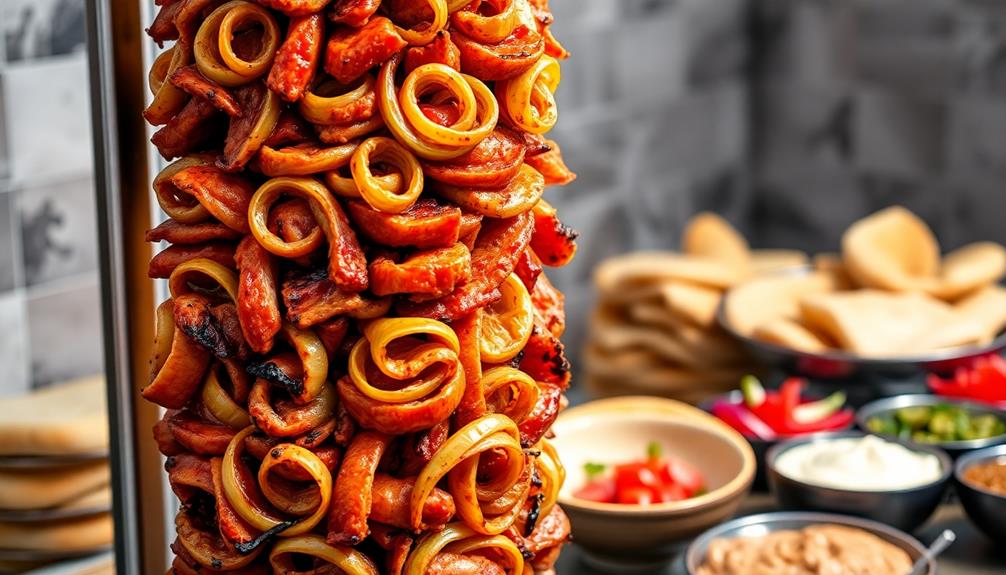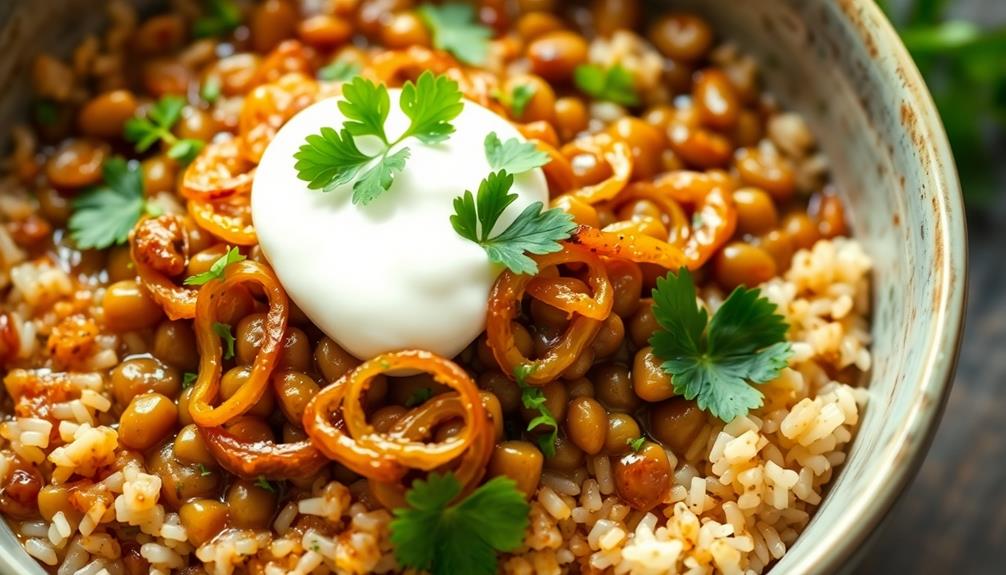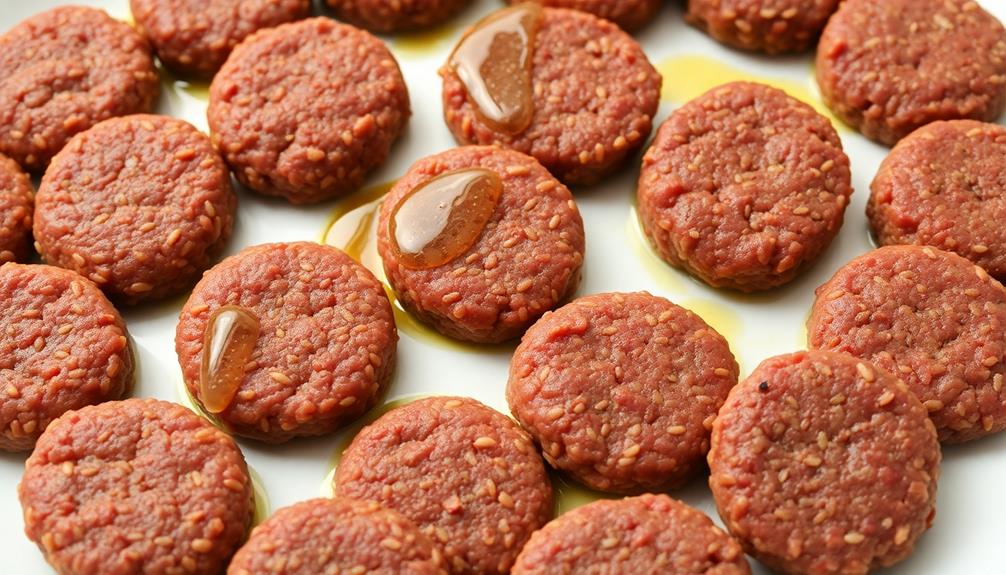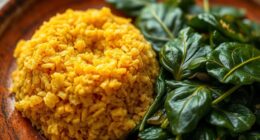Shawarma is a mouthwatering Middle Eastern dish that'll transport you on a culinary journey. Its origins trace back to the Ottoman Empire, where meat is stacked high on a vertical spit and slowly rotated to perfection. The tender, flavorful slices are then tucked into a soft pita bread, topped with fresh veggies, and often drizzled with tantalizing sauces. Whether you try the classic lamb, chicken, or beef, this versatile dish has something to delight every palate. Discover the rich cultural heritage and global appeal of shawarma – there's more to explore beyond this tasty introduction.
Key Takeaways
- Shawarma is a Middle Eastern dish featuring slowly roasted meat, typically lamb, chicken, or beef, served in pita bread or flatbread with various toppings.
- The cooking process involves stacking seasoned meat on a vertical rotisserie, allowing the fat to baste the meat as it slowly rotates.
- Shawarma has gained global popularity, with variations like Greek gyros and Mexican tacos al pastor, showcasing its adaptability across different culinary traditions.
- Shawarma is rich in protein due to its meat content and can be customized to accommodate dietary preferences, including vegan and gluten-free options.
- Shawarma represents a rich cultural heritage and the appreciation of centuries-old traditions, with the versatility allowing for creative experimentation with flavor combinations.
History
Shawarma, a beloved Middle Eastern dish, has a rich and captivating history that spans centuries. The origins of this savory treat can be traced back to the Ottoman Empire, where meat was cooked on a vertical spit, a technique known as doner kebab.
As the Ottoman Empire expanded, the dish spread throughout the region, evolving and adapting to local flavors and ingredients.
Over time, the doner kebab transformed into the shawarma we know and love today. The name "shawarma" is derived from the Arabic word "shawwara," meaning "to rotate." This refers to the slow-roasted meat that's carefully sliced off the spit, creating the signature layers of tender, flavorful meat.
Shawarma has become a staple in Middle Eastern cuisine, enjoyed by people from all walks of life. Its popularity has even spread across the globe, with shawarma shops and carts popping up in cities around the world.
Whether you're savoring it in its traditional form or trying a creative twist, the rich history of shawarma is sure to delight your taste buds.
Cooking Steps
To begin the cooking process, gather the necessary utensils and ingredients.
You'll need a large skillet or sauté pan, a sharp knife, and a cutting board. For the shawarma, you'll need thin slices of meat, such as chicken, beef, or lamb. Don't forget the pita bread, onions, tomatoes, and any other toppings you'd like.
Start by heating the skillet over medium-high heat. Add a bit of oil and arrange the meat slices in a single layer. Cook the meat, flipping occasionally, until it's nicely browned on both sides. This should take about 10-15 minutes.
While the meat is cooking, prepare the toppings. Slice the onions and tomatoes and set them aside.
Once the meat is cooked, transfer it to a cutting board and slice it into smaller pieces.
Now it's time to assemble your shawarma. Place a warm pita bread on a plate, add the sliced meat, and top it with the onions, tomatoes, and any other desired toppings.
Enjoy your delicious homemade shawarma!
Step 1. Vertically Stack Seasoned Meat
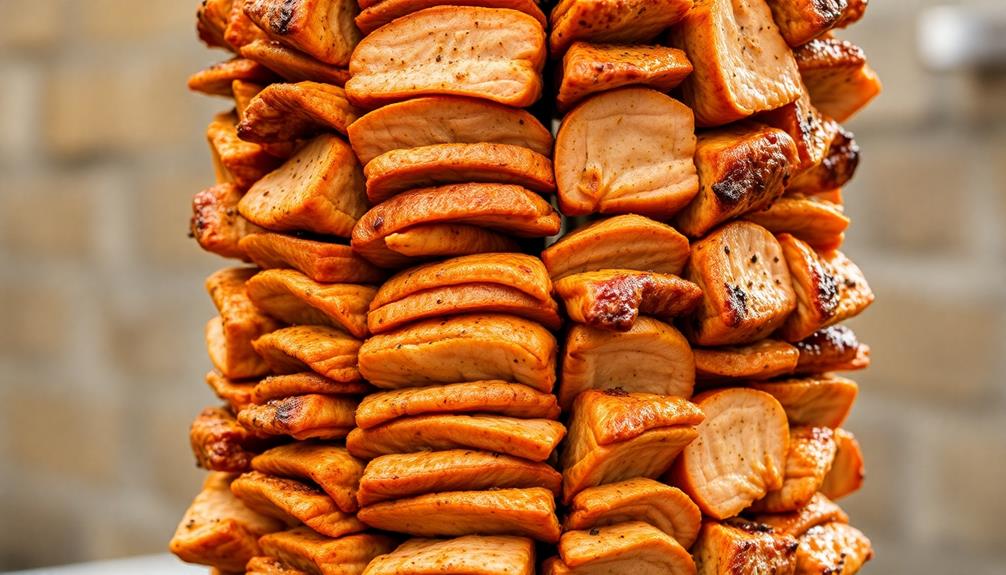
Take the seasoned meat and stack it vertically on the rotisserie spit. This is the key to creating that classic shawarma look and flavor. Carefully layer the meat, making sure it's packed tightly together.
As the spit spins, the meat will slowly cook, with the outer layers caramelizing and the inner layers staying juicy and tender.
Make sure to leave a small hole in the center of the stack so hot air can circulate all around the meat. This helps it cook evenly from the inside out.
As the meat cooks, the natural juices will drip down, basting the lower layers and adding even more delicious flavor.
Keep a close eye on the meat, turning the spit regularly to ensure even browning. When it's perfectly cooked, the outer layers will be crispy and golden brown, while the interior will be moist and flavorful.
Now you're ready to carve off those tasty shawarma slices and serve them up with all the fixings!
Step 2. Slowly Rotate the Stacked Meat
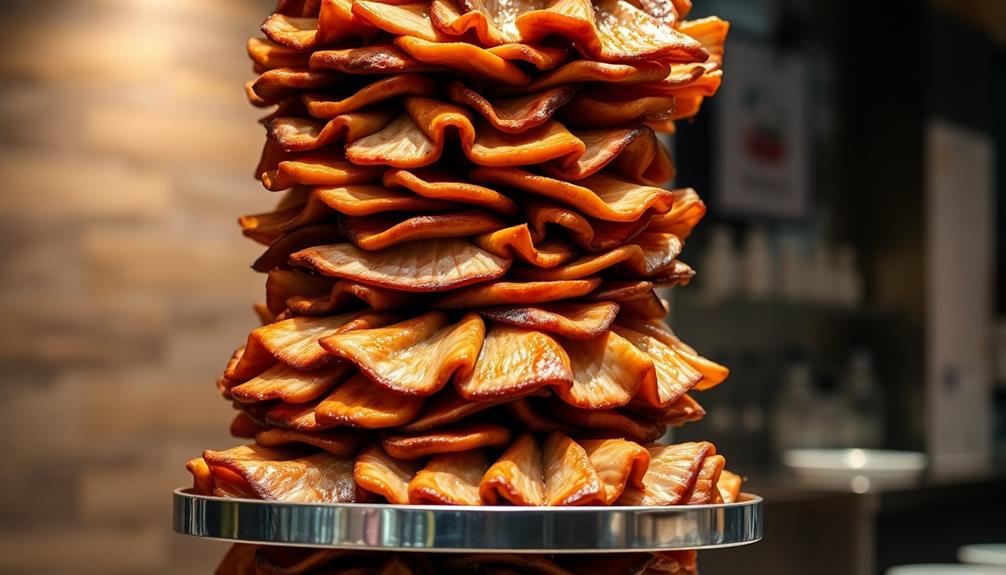
With the meat stacked and ready, it's time to slowly rotate the spit. This part is crucial for achieving that perfect, mouthwatering shawarma. Using a motor or a manual crank, gently turn the spit, making sure the meat rotates evenly.
The slow, steady rotation helps the meat cook through and develop that delicious, caramelized outer layer. As the spit turns, the fat from the meat will slowly drip down, basting the meat and adding to the flavor.
Keep a close eye on the rotation, adjusting the speed if needed to ensure even cooking. You'll know the meat is ready when the exterior is golden brown and crispy, and the interior is tender and juicy.
Remember to be patient during this process – good things come to those who wait! The slow rotation is what gives shawarma its signature texture and taste.
Keep turning that spit, and get ready for the most mouthwatering shawarma you've ever had.
Step 3. Shave Thin Meat Slices
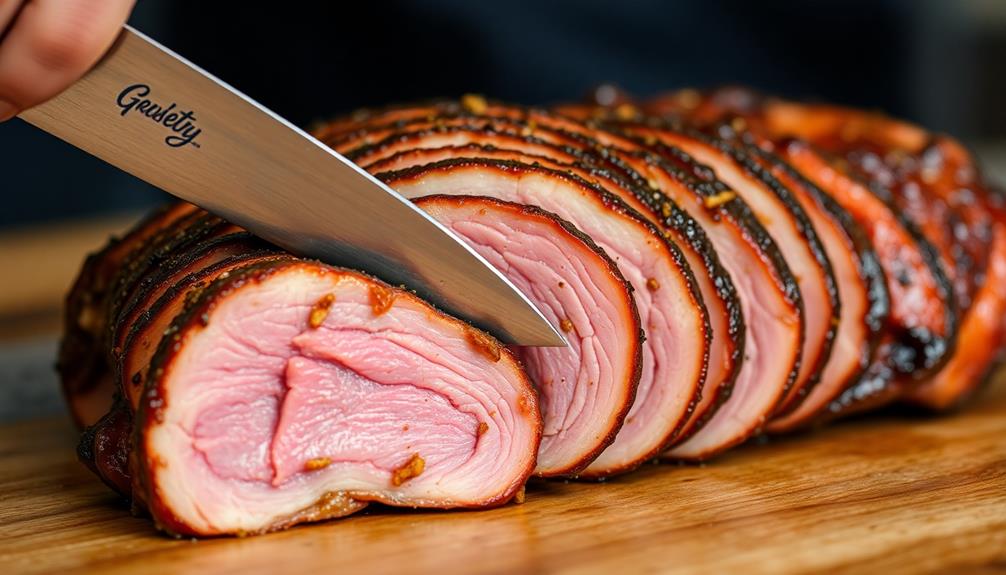
Once the meat has been slowly rotating on the spit, you'll want to carefully shave off thin, even slices. This is a crucial step in the shawarma-making process.
Use a sharp knife or an electric slicer to slice the meat as thinly as possible, creating delicate, translucent pieces. Be sure to hold the knife at a slight angle to the meat, gliding it across the surface in smooth, even strokes. This technique allows you to get the most out of the succulent, flavor-packed meat.
Take your time and work slowly, ensuring each slice is uniform in thickness. The thinner the slices, the more tender and flavorful the final shawarma will be.
As you shave the meat, you'll notice the aroma becoming more intense, teasing your senses and making your mouth water in anticipation. With each thin, delicate slice, you're one step closer to enjoying the perfect, authentic shawarma.
Step 4. Serve in a Pita Bread

Now that you've expertly shaved the meat into thin, aromatic slices, it's time to prepare the pita bread to serve your shawarma.
Take a fresh, warm pita and carefully slice it open, creating a pocket. Gently stuff the pita with the savory meat, ensuring it's evenly distributed. Don't be afraid to pack it in – you want a nice, substantial filling!
Next, add a generous helping of cool, crisp veggies like chopped tomatoes, onions, and lettuce. The contrast of the hot meat and cool veggies is simply divine.
Finally, drizzle your favorite sauces over the top, whether it's a zesty garlic sauce or a tangy tahini. The pita should now be overflowing with flavors and textures, ready to satisfy your cravings.
Wrap it up and enjoy this handheld delight on the go or savor it at the table. The perfect balance of spices, juicy meat, and freshly baked bread is sure to transport your taste buds to the heart of the Middle East.
Step 5. Add Garnish and Condiments

To add the final touches, garnish the stuffed pita with vibrant chopped parsley or a sprinkle of sumac for a pop of color and extra flavor.
Sumac is a tangy, lemony spice that adds a delightful zing to the shawarma. You can also drizzle a bit of tahini sauce over the top for a creamy, nutty accent.
For those looking to enhance the dish further, consider adding a side of fermented vegetable plate to boost the meal's nutritional value and probiotics.
Don't forget the pickled turnips! These bright pink, crunchy veggies make a perfect accompaniment, balancing the richness of the meat.
Thinly sliced onions, tomatoes, and cucumbers also make tasty additions, adding freshness and crunch.
For an extra special touch, serve the stuffed pita with a side of hot sauce or garlic sauce.
The fiery kick or garlicky goodness will take your shawarma experience to new heights. Get creative with your favorite condiments and enjoy the burst of flavors in every bite!
Final Thoughts
Shawarma has become a beloved and widely enjoyed culinary delight around the world. Whether you're savoring it in the bustling streets of the Middle East or whipping up your own version at home, this incredible dish never fails to satisfy.
The history of shawarma dates back thousands of years, with roots in the ancient cities of the Levant region. Traditionally made with seasoned meat, such as lamb, chicken, or beef, shawarma is cooked on a vertical rotisserie, resulting in tender and flavorful slices. Its rich history and global appeal have solidified shawarma as a beloved and enduring culinary classic.
The final touches, like garnishes and condiments, are what really make your shawarma experience unforgettable. From the zesty tang of pickled turnips to the cooling crunch of fresh veggies, the possibilities are endless. Don't be afraid to get creative and experiment with different flavor combinations.
After all, the beauty of shawarma lies in its versatility. So, the next time you indulge in this delectable treat, take a moment to appreciate the centuries-old traditions and flavors that come together in every bite.
Shawarma is more than just a meal – it's a cultural experience that transcends borders and brings people together. Savor every moment and let the flavors transport you to faraway lands.
Frequently Asked Questions
What Is the Difference Between Shawarma and Gyros?
You might be wondering, "What's the difference between shawarma and gyros?"
Well, let me tell you! Gyros are a Greek dish made with meat (usually lamb or beef) that's been stacked and roasted on a vertical spit.
Shawarma, on the other hand, is a Middle Eastern dish with seasoned meat (like chicken or lamb) that's cooked the same way.
Both are delicious, but they've distinct flavors and spices that set them apart!
Is Shawarma Considered a Healthy Food Option?
Is Shawarma a Healthy Food Option?
Ah, shawarma – that delicious, slow-roasted meat that's wrapped in soft, fluffy bread. But is it really a healthy choice? Well, it can be!
Shawarma is made with lean meats like chicken or beef, which provide protein to keep you feeling full and energized. The veggies and sauces that come with it also add valuable nutrients.
Just be mindful of portion sizes and any extra toppings that might pack on the calories. Enjoy shawarma as part of a balanced diet, and you can savor its flavors without guilt!
How Long Can Leftover Shawarma Be Stored?
Leftover shawarma can be stored in the fridge for 3-4 days.
Just make sure to keep it in an airtight container.
When you're ready to enjoy it again, you can heat it up in the microwave or oven.
The key is making sure it's piping hot all the way through.
That way, you can savor the delicious flavors of your leftover shawarma without worrying about food safety.
Yum!
Can I Make Shawarma at Home Without a Rotisserie?
Yes, you can definitely make shawarma at home without a rotisserie!
It's a bit more work, but the results are just as delicious. You'll need to marinate the meat, then sear it in a skillet or bake it in the oven until cooked through.
Slice it up, wrap it in warm pita bread, and top with your favorite veggies and sauces.
It may take some practice, but homemade shawarma is so worth it! You'll be impressing your friends and family in no time.
What Are the Most Common Shawarma Meat Options?
The most common shawarma meat options are chicken, beef, and lamb.
Chicken shawarma is the most popular, with its juicy, flavorful slices that melt in your mouth.
Beef shawarma offers a heartier, more savory taste, while lamb shawarma brings a slightly gamey yet delectable flavor.
No matter which meat you choose, you'll be treated to a delightful blend of spices that create an unforgettable taste sensation.
Which one will you try first?
